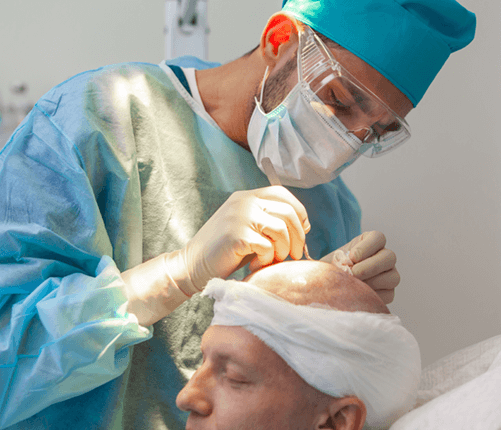Achieving a naturally fuller head of hair is made possible through hair transplant procedures. These treatments effectively combat the challenges of hair thinning and loss, and they offer a wide array of advantages.
- Operations
Real People, Real Results
Achieving a naturally fuller head of hair is made possible through hair transplant procedures. These treatments effectively combat the challenges of hair thinning and loss, and they offer a wide array of advantages.
Various methods have been devised to combat hair loss. Yet, the most successful and gratifying solution remains a well-executed hair transplant.
The primary cause of hair loss often lies in hereditary factors, resulting in male or female pattern baldness. If baldness runs in your family, you may be susceptible to this type of hair loss.
Temporary hair loss can also stem from hormonal fluctuations, such as those occurring during pregnancy, childbirth, or menopause.
Medical conditions like thyroid disease, alopecia areata (an autoimmune disorder attacking hair follicles), and scalp infections like ringworm can contribute to hair loss.
Additionally, certain medications used for conditions like cancer, high blood pressure, arthritis, depression, heart problems, physical / emotional shocks, significant weight reduction, or a severe fever, can trigger hair loss.

more then 100 million men suffer from hair loss worldwide. Over 650.000 of them undergo hair transplants as the most effective treatment option annually
Turkey listed top 3 in the most visited countries from medical tourists with its accredited hospitals with the latest technology, quality and, affordable healthcare
The procedure is included in the Top 3 most popular cosmetic procedures with men and women, and its popularity is increasing
The physician assesses the requisite follicle count for optimal outcomes. Thorough tests and inquiries determine your eligibility for hair transplant surgery. Additionally, the selection of the donor region for graft extraction will be finalized.
Prior to the procedure, your physician will outline essential steps. It is imperative to heed all provided recommendations for a successful intervention.
Trimming hair in the donor area precedes graft extraction. The needed graft quantity for transplantation is determined by the dimensions and definition of the target region.
Upon completing all procedures, the front cut line is established to harmonize with the patient's facial contours. Subsequently, the transplantation is executed using the suitable method.
Following the surgery, a prolonged journey to the desired outcome unfolds. The final result manifests after 12 months. Attaining the intended result requires patients to diligently adhere to recovery recommendations.
Adhering to instructions and medical advice significantly increases the likelihood of patients achieving their desired result.
 Türkiye
Türkiye France
France Netherland
NetherlandSeveral methods and techniques exist for hair transplantation, but currently, four are experiencing the highest demand.
In the FUE hair transplant method, the surgeon extracts healthy and robust hair follicles from scalp regions where they naturally thrive. This is typically done through punch incisions using a specially designed needle. Subsequently, these follicles are implanted into pre-opened holes on the scalp in areas experiencing hair loss.
An experienced and well-trained surgeon can successfully transplant 4500-6000 follicles within a specified timeframe. Following the procedure, both donor and recipient areas are covered with bandages or gauze to facilitate healing and prevent infections.
The necessity for multiple sessions may arise based on factors such as the patient's hair quality, the size of areas affected by hair loss, and the desired follicle density, ensuring the achievement of planned results.
The primary distinction between DHI and the FUE method lies in the tools employed during the operation. Instead of punches, the operation utilizes "needles" known as Choi pens, available in various sizes. The width of the Choi pen is determined by the hair transplant surgeon based on the patient's needs.
Choi pens facilitate a more precise extraction process, penetrating the skin to collect follicles with minimal disturbance to the surrounding area. This eliminates the risk of forming holes on the scalp, a potential drawback of the FUE technique. Notably, DHI stands out as the least invasive method of hair transplantation, ensuring the absence of scar marks, irrespective of its success.
;Sapphire FUE closely resembles the traditional FUE technique, differing primarily in the tool used during the procedure. In this method, a sapphire blade replaces the conventional razor or steel blade for opening channels on the scalp during hair transplantation.
During the initial phase of hair transplantation, follicles are extracted and transplanted into areas prepared by the sapphire blades. The process of opening these channels holds paramount importance in the overall hair transplant procedure. The narrow openings created by sapphire blades significantly impact the density, angle, and direction of hair growth, ensuring grafts can be placed precisely without external contact.
;In the FUT hair transplant procedure, the surgeon initially extracts a strip of the patient's scalp skin, closing the incision with stitches. The incision and potential scarring remain concealed beneath the patient's hair.
The excised scalp skin is then divided into smaller sections using surgical knives. These sections are subsequently implanted into areas of the patient's scalp experiencing hair loss, fostering natural-looking hair growth in previously bald regions after complete recovery.
Alternatively, patients may opt for more advanced technologies such as FUE, Sapphire, or DHI transplant methods.
;The duration of the procedure may differ for each individual, but generally;
6-8 hours
Local Anesthesia
8-12 months
Voluminous Hair Appearance
DHI
The prevailing belief that hair loss is exclusive to males is a misconception. Statistics disclose that one in four individuals, irrespective of gender, contends with hair loss at some stage in their life.
Numerous methods exist to counteract hair loss, yet the most efficacious and gratifying solution among them is undoubtedly a hair transplant.
A skilled hair transplantation specialist assesses hair loss type, ratio, and potential causes to determine the need for a transplant. If recommended, the expert identifies the suitable method. Hair transplantation is viable for individuals aged 22 and above.

Frequently Asked Questions

Explore our informative articles and peruse our blogs for in-depth insights on topics that capture your interest.